Plasmon Effect of Ag Nanoparticles on TiO2/rGO Nanostructures for Enhanced Energy Harvesting and Environmental Remediation
Abstract
1. Introduction
2. Experimental Section
2.1. Materials and Reagents
2.2. Preparation of TiO2 Mesospheres
2.3. Preparation of Graphene Oxide (GO)
2.4. Preparation of Mesosphere TiO2/rGO Sample
2.5. Preparation of TiO2/rGO/Ag Hybrid Nanostructure by In Situ Growth
2.6. Characterization
2.7. Photocatalytic Experiments
2.8. DSSC Device Fabrication
3. Results and Discussion
3.1. Structural and Compositional Analysis
3.2. Morphological Analysis
3.3. Optical and Surface Area Analysis
3.4. Performance of DSSC Device
3.5. Photocatalytic Performance
4. Conclusions
Supplementary Materials
Author Contributions
Funding
Data Availability Statement
Conflicts of Interest
References
- Jamil, F.; Ali, H.M.; Janjua, M.M. MXene based advanced materials for thermal energy storage: A recent review. J. Energy Storage 2021, 35, 102322. [Google Scholar] [CrossRef]
- Sözen, A.; Filiz, C.; Aytaç, I.; Martin, K.; Ali, H.M.; Boran, K.; Yetişken, Y. Upgrading of the performance of an air-to-air heat exchanger using graphene/water nanofluid. Int. J. Thermophys. 2021, 42, 1–15. [Google Scholar] [CrossRef]
- Jacoby, M. Commercializing low-cost solar cells. C&EN Glob. Enterp. 2016, 94, 30–35. [Google Scholar] [CrossRef][Green Version]
- Hattori, Y.; Álvarez, S.G.; Meng, J.; Zheng, K.; Sá, J. Role of the Metal oxide electron acceptor on gold–plasmon hot-carrier dynamics and its implication to photocatalysis and photovoltaics. ACS Appl. Nano Mater. 2021, 4, 2052–2060. [Google Scholar] [CrossRef]
- Hisatomi, T.; Kubota, J.; Domen, K. Recent advances in semiconductors for photocatalytic and photoelectrochemical water splitting. Chem. Soc. Rev. 2014, 43, 7520–7535. [Google Scholar] [CrossRef]
- Choudhury, B.D.; Lin, C.; Shawon, S.M.A.Z.; Soliz-Martinez, J.; Huq, H.; Uddin, M.J. A photoanode with hierarchical nanoforest TiO2 structure and silver plasmonic nanoparticles for flexible dye sensitized solar cell. Sci. Rep. 2021, 11, 7552. [Google Scholar] [CrossRef]
- Li, Z.; Sun, Z.; Duan, Z.; Li, R.; Yang, Y.; Wang, J.; Lv, X.; Qi, W.; Wang, H. Super-hydrophobic silver-doped TiO2 @ polycarbonate coatings created on various material substrates with visible-light photocatalysis for self-cleaning contaminant degradation. Sci. Rep. 2017, 7, 42932. [Google Scholar] [CrossRef]
- Jing, L.; Zhou, W.; Tian, G.; Fu, H. Surface tuning for oxide-based nanomaterials as efficient photocatalysts. Chem. Soc. Rev. 2013, 42, 9509–9549. [Google Scholar] [CrossRef]
- O’Regan, B.; Grätzel, M. A low-cost, high-efficiency solar cell based on dye-sensitized colloidal TiO2 films. Nature 1991, 353, 737–740. [Google Scholar] [CrossRef]
- Low, J.; Jiang, C.; Cheng, B.; Wageh, S.; Al-Ghamdi, A.A.; Yu, J. A Review of girect Z-scheme photocatalysts. Small Methods 2017, 1, 1–21. [Google Scholar] [CrossRef]
- Graciani, J.; Álvarez, L.J.; Rodriguez, J.A.; Sanz, J.F. N Doping of rutile TiO2 (110) surface. A theoretical DFT study. J. Phys. Chem. C 2008, 112, 2624–2631. [Google Scholar] [CrossRef]
- Shah, S.A.S.; Zhang, K.; Park, A.R.; Kim, K.S.; Park, N.-G.; Park, J.H.; Yoo, P.J. Single-step solvothermal synthesis of mesoporous Ag–TiO2–reduced graphene oxide ternary composites with enhanced photocatalytic activity. Nanoscale 2010, 5, 5093–5101. [Google Scholar] [CrossRef]
- Wang, P.; Li, H.; Cao, Y.; Yu, H. Carboxyl-functionalized graphene for highly efficient H2-evolution activity of TiO2 photocatalyst. Acta Phys. Chim. Sin. 2021, 37, 2008047. [Google Scholar] [CrossRef]
- Li, J.; Wu, X.; Liu, S. Fluorinated TiO2 hollow photocatalysts for photocatalytic applications. Acta Phys. Chim. Sin. 2021, 37, 2009038. [Google Scholar] [CrossRef]
- Schedin, F.; Geim, A.K.; Morozov, S.V.; Hill, E.W.; Blake, P.; Katsnelson, M.I.; Novoselov, K.S. Detection of individual gas molecules adsorbed on graphene. Nat. Mater. 2007, 6, 652–655. [Google Scholar] [CrossRef] [PubMed]
- Zhang, N.; Zhang, Y.; Xu, Y.-J. Recent progress on graphene-based photocatalysts: Current status and future perspectives. Nanoscale 2012, 4, 5792–5813. [Google Scholar] [CrossRef] [PubMed]
- Zhang, X.-Y.; Li, H.-P.; Cui, X.-L.; Lin, Y. Graphene/TiO2 nanocomposites: Synthesis, characterization and application in hydrogen evolution from water photocatalytic splitting. J. Mater. Chem. 2010, 20, 2801–2806. [Google Scholar] [CrossRef]
- Roy-Mayhew, J.D.; Aksay, I.A. Graphene materials and their use in dye-sensitized solar cells. Chem. Rev. 2014, 114, 6323–6348. [Google Scholar] [CrossRef] [PubMed]
- Manikandan, V.; Palai, A.; Mohanty, S.; Nayak, S. Hydrothermally synthesized self-assembled multi-dimensional TiO2/graphene oxide composites with efficient charge transfer kinetics fabricated as novel photoanode for dye sensitized solar cell. J. Alloys Compd. 2019, 793, 400–409. [Google Scholar] [CrossRef]
- Kandasamy, M.; Selvaraj, M.; Kumarappan, C.; Murugesan, S. Plasmonic Ag nanoparticles anchored ethylenediamine modified TiO2 nanowires@graphene oxide composites for dye-sensitized solar cell. J. Alloys Compd. 2022, 902, 163743. [Google Scholar] [CrossRef]
- Zhao, D.; Yang, X.; Chen, C.; Wang, X. Enhanced photocatalytic degradation of methylene blue on multiwalled carbon nanotubes–TiO2. J. Colloid Interface Sci. 2013, 398, 234–239. [Google Scholar] [CrossRef] [PubMed]
- Din, M.I.; Khalid, R.; Najeeb, J.; Hussain, Z. Fundamentals and photocatalysis of methylene blue dye using various nanocatalytic assemblies- a critical review. J. Clean. Prod. 2021, 298, 126567. [Google Scholar] [CrossRef]
- Parsa, S.M.; Yazdani, A.; Dhahad, H.; Alawee, W.H.; Hesabi, S.; Norozpour, F.; Javadi, D.; Ali, H.M.; Afrand, M. Effect of Ag, Au, TiO2 metallic/metal oxide nanoparticles in double-slope solar stills via thermodynamic and environmental analysis. J. Clean. Prod. 2021, 311, 127689. [Google Scholar] [CrossRef]
- Xiao, M.; Jiang, R.; Wang, F.; Fang, C.; Wang, J.; Jimmy, C.Y. Plasmon-enhanced chemical reactions. J. Mater. Chem. A 2013, 1, 5790–5805. [Google Scholar] [CrossRef]
- Wang, P.; Wang, J.; Wang, X.; Yu, H.; Yu, J.; Lei, M.; Wang, Y. One-step synthesis of easy-recycling TiO2-rGO nanocomposite photocatalysts with enhanced photocatalytic activity. Appl. Catal. B Environ. 2013, 132–133, 452–459. [Google Scholar] [CrossRef]
- Xiao, H.; Wang, T. Graphene oxide (rGO)-metal oxide (TiO2/Ag2O) based nanocomposites for the removal of rhodamine B at UV–visible light. J. Phys. Chem. Solids 2021, 154, 110100. [Google Scholar] [CrossRef]
- Akyüz, D. rGO-TiO2-CdO-ZnO-Ag photocatalyst for enhancing photocatalytic degradation of methylene blue. Opt. Mater. 2021, 116, 111090. [Google Scholar] [CrossRef]
- Mahmoudabadi, Z.D.; Eslami, E.; Narimisa, M. Synthesis of Ag/TiO2 nanocomposite via plasma liquid interactions: Improved performance as photoanode in dye-sensitized solar cell. J. Colloid Interface Sci. 2018, 529, 538–546. [Google Scholar] [CrossRef]
- Hummers, W.S., Jr.; Offeman, R.E. Preparation of graphitic oxide. J. Am. Chem. Soc. 1957, 80, 1339. [Google Scholar] [CrossRef]
- Wang, T.; Tang, T.; Gao, Y.; Chen, Q.; Zhang, Z.; Bian, H. Hydrothermal preparation of Ag-TiO2-reduced graphene oxide ternary microspheres structure composite for enhancing photocatalytic activity. Phys. E Low-Dimens. Syst. Nanostructures 2019, 112, 128–136. [Google Scholar] [CrossRef]
- Abadikhah, H.; Kalali, E.N.; Khodi, S.; Xu, X.; Agathopoulos, S. Multifunctional thin-film nanofiltration membrane incorporated with reduced graphene oxide@TiO2@Ag nanocomposites for high desalination performance, dye retention, and antibacterial properties. ACS Appl. Mater. Interfaces 2019, 11, 23535–23545. [Google Scholar] [CrossRef]
- Kudin, K.N.; Ozbas, B.; Schniepp, H.C.; Prud’Homme, R.K.; Aksay, I.A.; Car, R. Raman spectra of graphite oxide and functionalized graphene sheets. Nano Lett. 2008, 8, 36–41. [Google Scholar] [CrossRef]
- Zheng, Q.; Zhang, B.; Lin, X.; Shen, X.; Yousefi, N.; Huang, Z.-D.; Li, Z.; Kim, J.-K. Highly transparent and conducting ultralarge graphene oxide/single-walled carbon nanotube hybrid films produced by Langmuir–Blodgett assembly. J. Mater. Chem. 2012, 22, 25072–25082. [Google Scholar] [CrossRef]
- How, G.T.S.; Pandikumar, A.; Ming, H.N.; Ngee, L.H. Highly exposed {001} facets of titanium dioxide modified with reduced graphene oxide for dopamine sensing. Sci. Rep. 2014, 4, 5044. [Google Scholar] [CrossRef]
- Shah, S.A.S.; Park, A.R.; Zhang, K.; Park, J.H.; Yoo, P.J. Green synthesis of biphasic TiO2–reduced graphene oxide nanocomposites with highly enhanced photocatalytic activity. ACS Appl. Mater. Interfaces 2012, 4, 3893–3901. [Google Scholar] [CrossRef] [PubMed]
- Wen, Y.; Ding, H.; Shan, Y. Preparation and visible light photocatalytic activity of Ag/TiO2/graphene nanocomposite. Nanoscale 2011, 3, 4411–4417. [Google Scholar] [CrossRef] [PubMed]
- Sopinskyy, M.V.; Khomchenko, V.S.; Strelchuk, V.V.; Nikolenko, A.S.; Olchovyk, G.P.; Vishnyak, V.V.; Stonis, V.V. Possibility of graphene growth by close space sublimation. Nanoscale Res. Lett. 2014, 9, 182. [Google Scholar] [CrossRef]
- Kisielewska, A.; Spilarewicz-Stanek, K.; Cichomski, M.; Kozłowski, W.; Piwoński, I. The role of graphene oxide and its reduced form in the in situ photocatalytic growth of silver nanoparticles on graphene-TiO2 nanocomposites. Appl. Surf. Sci. 2021, 576, 151759. [Google Scholar] [CrossRef]
- Pastrana-Martínez, L.M.; Morales-Torres, S.; Likodimos, V.; Falaras, P.; Figueiredo, J.L.; Faria, J.L.; Silva, A.M. Role of oxygen functionalities on the synthesis of photocatalytically active graphene–TiO2 composites. Appl. Catal. B Environ. 2014, 158–159, 329–340. [Google Scholar] [CrossRef]
- Leong, K.H.; Sim, L.C.; Bahnemann, D.; Jang, M.; Ibrahim, S.; Saravanan, P. Reduced graphene oxide and Ag wrapped TiO2 photocatalyst for enhanced visible light photocatalysis. APL Mater. 2015, 3, 104503. [Google Scholar] [CrossRef]
- Li, J.-J.; Cai, S.-C.; Yu, E.-Q.; Weng, B.; Chen, X.; Chen, J.; Jia, H.-P.; Xu, Y.-J. Efficient infrared light promoted degradation of volatile organic compounds over photo-thermal responsive Pt-rGO-TiO2 composites. Appl. Catal. B Environ. 2018, 233, 260–271. [Google Scholar] [CrossRef]
- Fang, R.; Miao, C.; Mou, H.; Xiao, W. Facile synthesis of Si@TiO2@rGO composite with sandwich-like nanostructure as superior performance anodes for lithium ion batteries. J. Alloys Compd. 2020, 818, 152884. [Google Scholar] [CrossRef]
- Ma, J.; Dai, J.; Duan, Y.; Zhang, J.; Qiang, L.; Xue, J. Fabrication of PANI-TiO2/rGO hybrid composites for enhanced photocatalysis of pollutant removal and hydrogen production. Renew. Energy 2020, 156, 1008–1018. [Google Scholar] [CrossRef]
- Wang, Y.; Yu, J.; Xiao, W.; Li, Q. Microwave-assisted hydrothermal synthesis of graphene based Au–TiO2 photocatalysts for efficient visible-light hydrogen production. J. Mater. Chem. A 2014, 2, 3847–3855. [Google Scholar] [CrossRef]
- Wu, Y.; Liu, H.; Zhang, J.; Chen, F. Enhanced photocatalytic activity of nitrogen-doped titania by deposited with gold. J. Phys. Chem. C 2009, 113, 14689–14695. [Google Scholar] [CrossRef]
- Yang, D.; Wang, M.; Zou, B.; Zhang, G.L.; Lin, Z. An external template-free route to uniform semiconducting hollow mesospheres and their use in photocatalysis. Nanoscale 2015, 7, 12990–12997. [Google Scholar] [CrossRef]
- Guo, T.-L.; Li, J.-G.; Sun, X.; Sakka, Y. Photocatalytic growth of Ag nanocrystals on hydrothermally synthesized multiphasic TiO2/reduced graphene oxide (rGO) nanocomposites and their SERS performance. Appl. Surf. Sci. 2017, 423, 1–12. [Google Scholar] [CrossRef]
- Alsharaeh, E.H.; Bora, T.; Soliman, A.; Ahmed, F.; Bharath, G.; Ghoniem, M.G.; Abu-Salah, K.M.; Dutta, J. Sol-Gel-sssisted microwave-derived synthesis of anatase Ag/TiO2/GO nanohybrids toward efficient visible light phenol degradation. Catalysts 2017, 7, 133. [Google Scholar] [CrossRef]
- Jie, Z.; Xiao, X.; Huan, Y.; Youkang, H.; Zhiyao, Z. The preparation and characterization of TiO2/r-GO/Ag nanocomposites and its photocatalytic activity in formaldehyde degradation. Environ. Technol. 2021, 42, 193–205. [Google Scholar] [CrossRef]
- Li, L.; Zhai, L.; Liu, H.; Li, B.; Li, M.; Wang, B. A novel H2O2 photoelectrochemical sensor based on ternary RGO/Ag-TiO2 nanotube arrays nanocomposite. Electrochim. Acta 2021, 374, 137851. [Google Scholar] [CrossRef]
- Senthilkumar, N.; Sheet, S.; Sathishkumar, Y.; Lee, Y.S.; Phang, S.-M.; Periasamy, V.; Kumar, G.G. Titania/reduced graphene oxide composite nanofibers for the direct extraction of photosynthetic electrons from microalgae for biophotovoltaic cell applications. Appl. Phys. A 2018, 124, 769. [Google Scholar] [CrossRef]
- Zhang, H.; Wang, X.; Li, N.; Xia, J.; Meng, Q.; Ding, J.; Lu, J. Synthesis and characterization of TiO2/graphene oxide nanocomposites for photoreduction of heavy metal ions in reverse osmosis concentrate. RSC Adv. 2018, 60, 34241–34251. [Google Scholar] [CrossRef]
- Qiu, B.; Zhou, Y.; Ma, Y.; Yang, X.; Sheng, W.; Xing, M.; Zhang, J. Facile synthesis of the Ti3+ self-doped TiO2-graphene nanosheet composites with enhanced photocatalysis. Sci. Rep. 2015, 5, 8591. [Google Scholar] [CrossRef]
- Li, M.; Yuan, N.; Tang, Y.; Pei, L.; Zhu, Y.; Liu, J.; Bai, L.; Li, M. Performance optimization of dye-sensitized solar cells by gradient-ascent architecture of SiO2@Au@TiO2 microspheres embedded with Au nanoparticles. J. Mater. Sci. Technol. 2018, 35, 604–609. [Google Scholar] [CrossRef]
- Irannejad, N.; Rezaei, B.; Ensafi, A.A.; Momeni, M.M. Enhanced efficiency of dye-sensitized solar cell by using a novel modified photoanode with platinum C3N4 nanotubes incorporated Ag/TiO2 nanoparticles. Electrochim. Acta 2017, 247, 764–770. [Google Scholar] [CrossRef]
- Subramaniam, M.R.; Kumaresan, D.; Jothi, S.; McGettrick, J.D.; Watson, T.M. Reduced graphene oxide wrapped hierarchical TiO2 nanorod composites for improved charge collection efficiency and carrier lifetime in dye sensitized solar cells. Appl. Surf. Sci. 2018, 428, 439–447. [Google Scholar] [CrossRef]
- Ahmad, I.; Jafer, R.; Abbas, S.M.; Ahmad, N.; Rehman, A.U.; Iqbal, J.; Bashir, S.; Melaibari, A.A.; Khan, M.H. Improving energy harvesting efficiency of dye sensitized solar cell by using cobalt-rGO co-doped TiO2 photoanode. J. Alloys Compd. 2022, 891, 162040. [Google Scholar] [CrossRef]
- Cai, H.; Li, J.; Xu, X.; Tang, H.; Luo, J.; Binnemans, K.; Fransaer, J.; De Vos, D.E. Nanostructured composites of one-dimensional TiO2 and reduced graphene oxide for efficient dye-sensitized solar cells. J. Alloys Compd. 2017, 697, 132–137. [Google Scholar] [CrossRef]
- Hidayat, A.; Taufiq, A.; Supardi, Z.; Jayadininggar, S.; Sa’Adah, U.; Astarini, N.; Suprayogi, T.; Diantoro, M. Synthesis and characterization of TiO2/ZnO-Ag@TiO2 nanocomposite and their performance as photoanode of organic dye-sensitized solar cell. Mater. Today Proc. 2020, 44, 3395–3399. [Google Scholar] [CrossRef]
- DuChene, J.S.; Sweeny, B.C.; Johnston-Peck, A.C.; Su, D.; Stach, E.A.; Wei, W.D. Prolonged hot electron dynamics in plasmonic-metal/semiconductor heterostructures with implications for solar photocatalysis. Angew. Chem. Int. Ed. 2014, 53, 7887–7891. [Google Scholar] [CrossRef]
- He, Y.; Basnet, P.; Murph, S.E.H.; Zhao, Y. Ag nanoparticle embedded TiO2 composite nanorod arrays fabricated by oblique angle deposition: Toward plasmonic photocatalysis. ACS Appl. Mater. Interfaces 2013, 5, 11818–11827. [Google Scholar] [CrossRef] [PubMed]
- Mansfeldova, V.; Zlamalova, M.; Tarabkova, H.; Janda, P.; Vorokhta, M.; Piliai, L.; Kavan, L. Work Function of TiO2 (anatase, rutile, and brookite) single crystals: Effects of the environment. J. Phys. Chem. C 2021, 125, 1902–1912. [Google Scholar] [CrossRef]
- Garrafa-Gálvez, H.E.; Alvarado-Beltrán, C.G.; Almaral-Sánchez, J.L.; Hurtado-Macías, A.; Garzon-Fontecha, A.M.; Luque, P.A.; Castro-Beltrán, A. Graphene role in improved solar photocatalytic performance of TiO2-RGO nanocomposite. Chem. Phys. 2019, 521, 35–43. [Google Scholar] [CrossRef]
- Jaihindh, D.P.; Chen, C.-C.; Fu, Y.-P. Reduced graphene oxide-supported Ag-loaded Fe-doped TiO2 for the degradation mechanism of methylene blue and its electrochemical properties. RSC Adv. 2018, 8, 6488–6501. [Google Scholar] [CrossRef] [PubMed]
- Wang, W.; Xiao, K.; Zhu, L.; Yin, Y.; Wang, Z. Graphene oxide supported titanium dioxide & ferroferric oxide hybrid, a magnetically separable photocatalyst with enhanced photocatalytic activity for tetracycline hydrochloride degradation. RSC Adv. 2017, 7, 21287–21297. [Google Scholar] [CrossRef]
- Li, T.; Wang, T.; Qu, G.; Liang, D.; Hu, S. Synthesis and photocatalytic performance of reduced graphene oxide–TiO2 nanocomposites for orange II degradation under UV light irradiation. Environ. Sci. Pollut. Res. 2017, 24, 12416. [Google Scholar] [CrossRef]
- Ganguly, P.; Mathew, S.; Clarizia, L.; Kumar, S.; Akande, A.; Hinder, S.; Breen, A.; Pillai, S.C. Theoretical and experimental investigation of visible light responsive AgBiS2-TiO2 heterojunctions for enhanced photocatalytic applications. Appl. Catal. B Environ. 2019, 253, 401–418. [Google Scholar] [CrossRef]
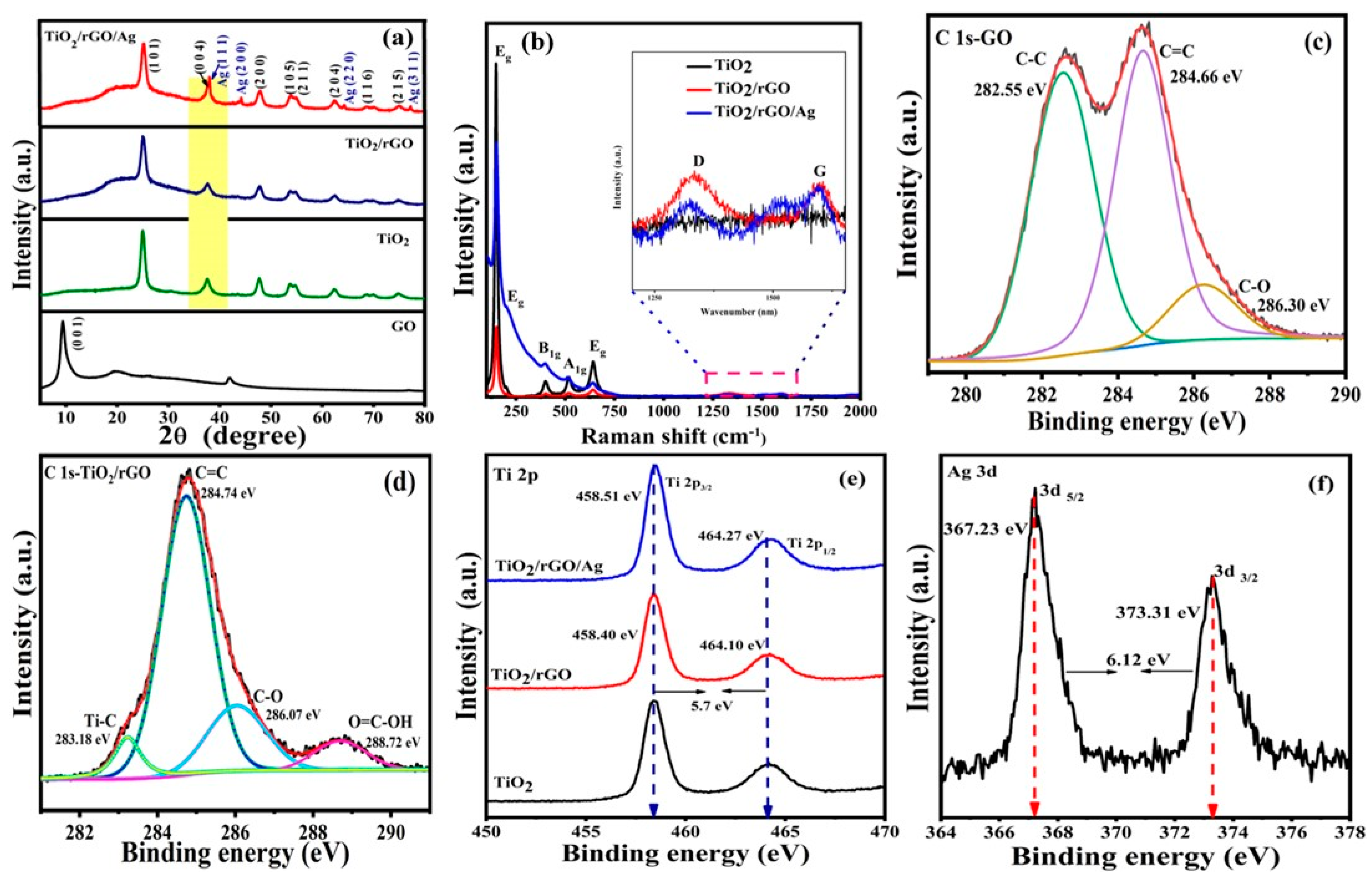
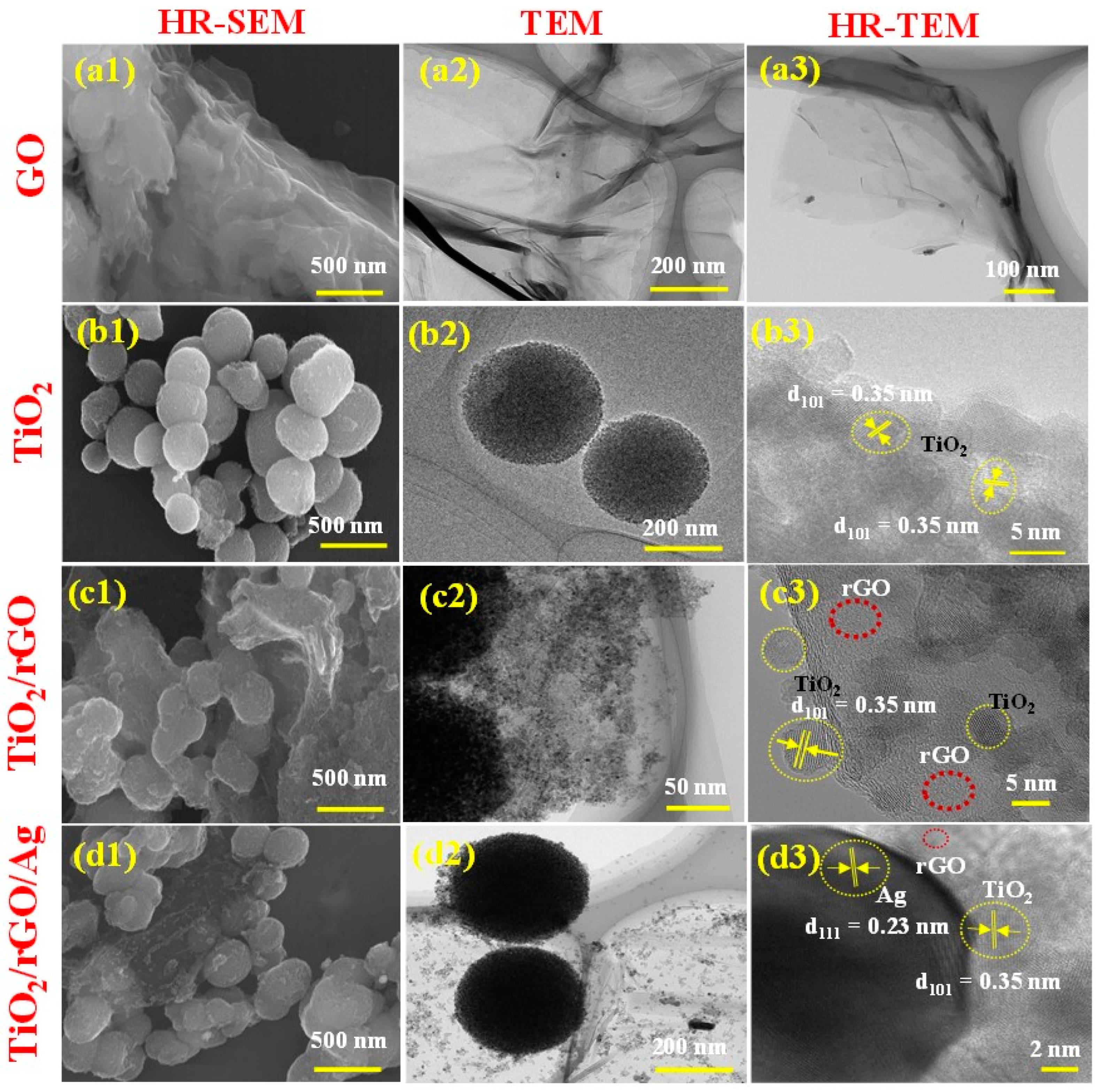
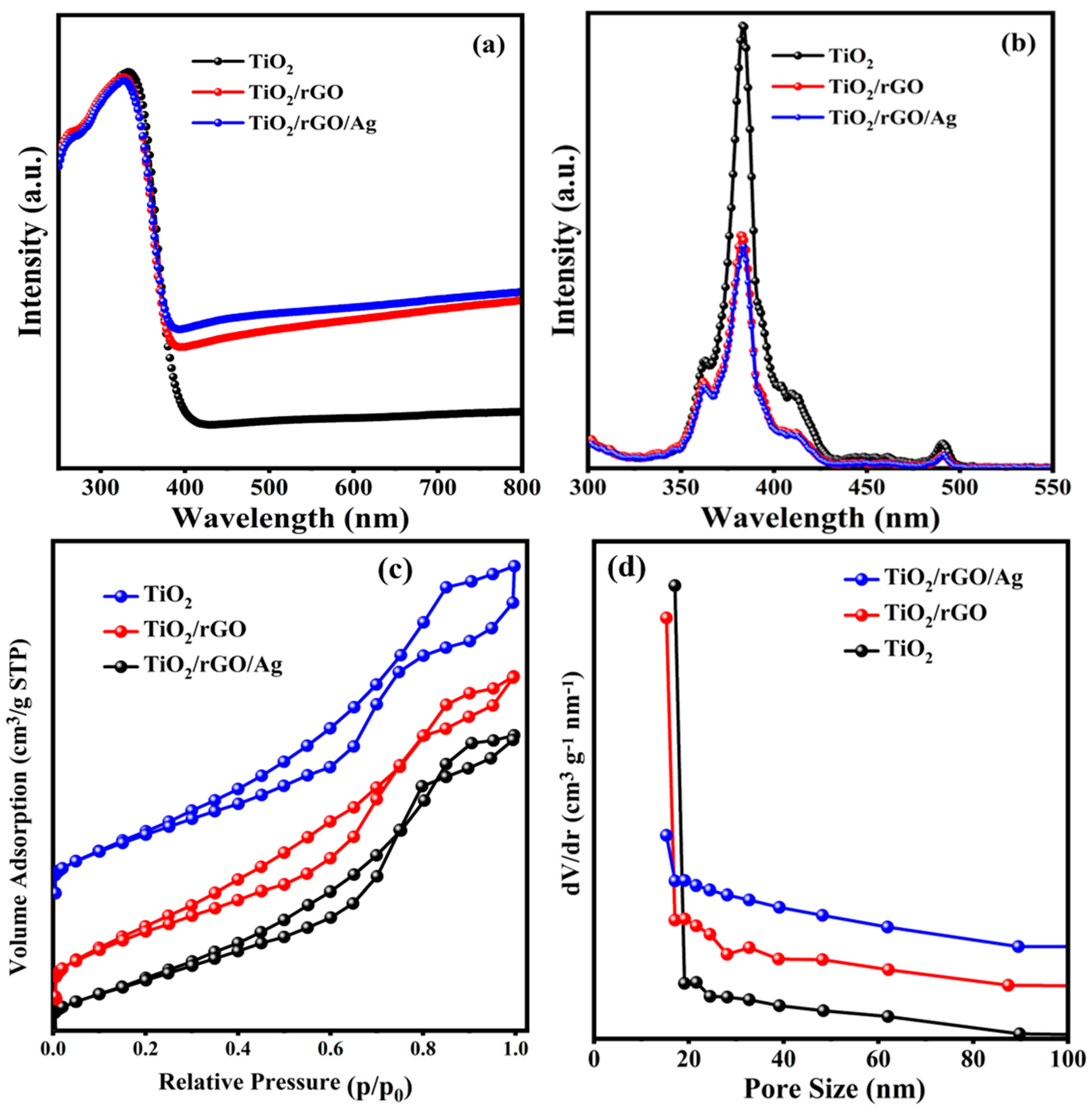
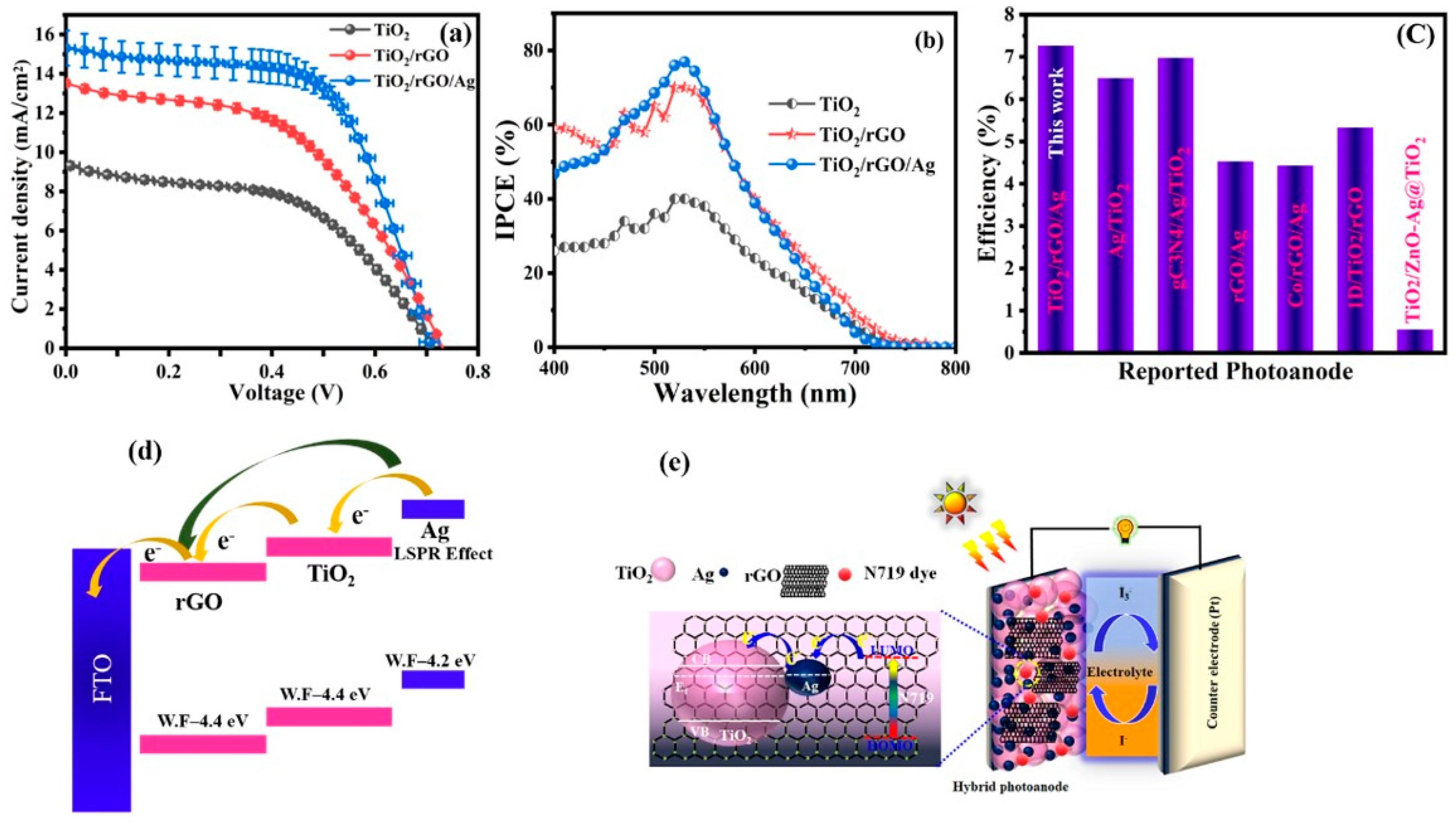

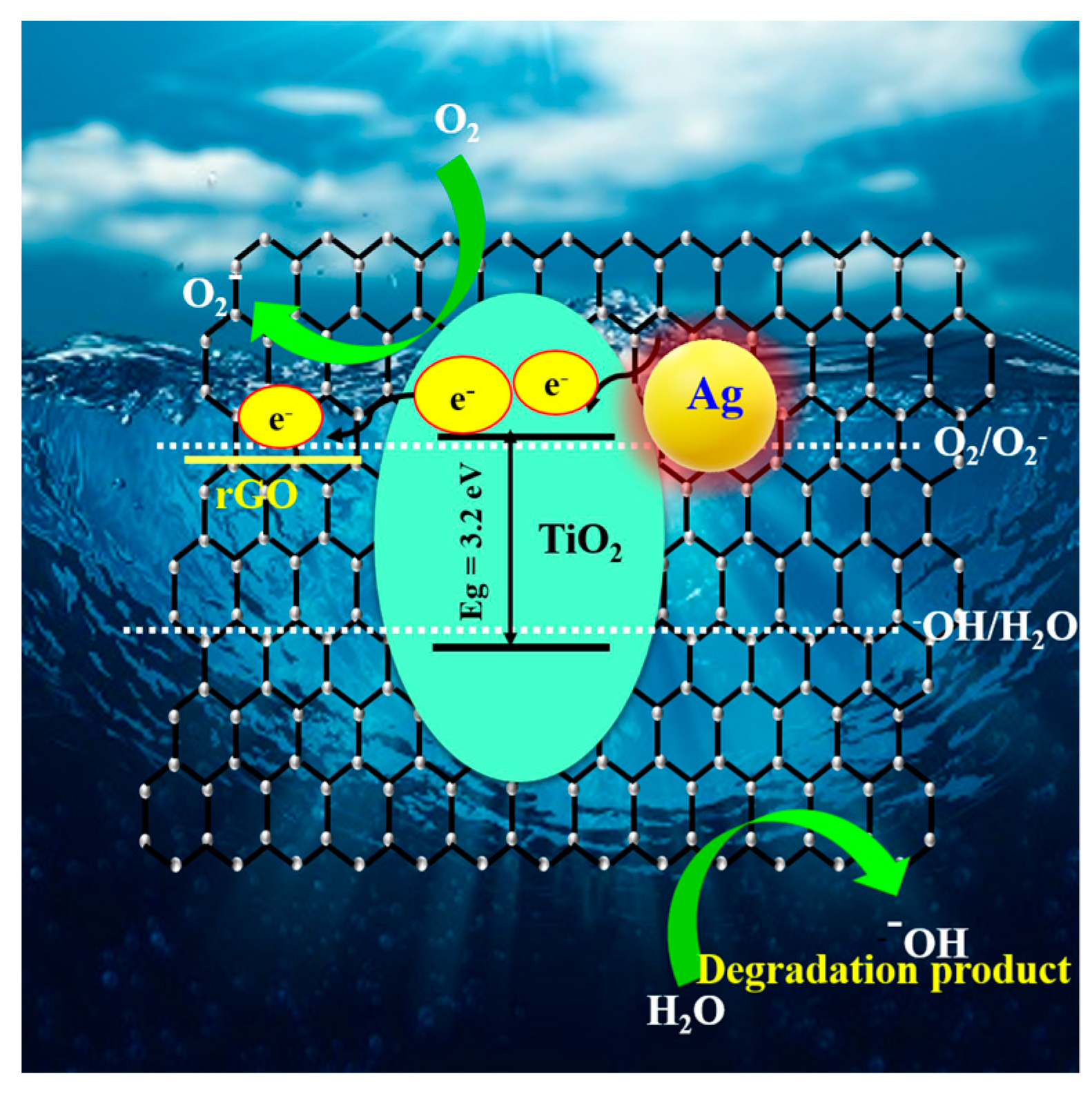
| Photoanode | Surface Area (m2/g) | JSC (mA/cm2) | VOC (V) | FF (%) | η ( %) |
|---|---|---|---|---|---|
| TiO2 | 234.16 | 9.50 | 0.70 | 51.0 | 4.10 |
| TiO2/rGO | 281.31 | 13.80 | 0.74 | 55.0 | 5.00 |
| TiO2/rGO/Ag | 297.71 | 16.05 | 0.74 | 62.5 | 7.27 |
Disclaimer/Publisher’s Note: The statements, opinions and data contained in all publications are solely those of the individual author(s) and contributor(s) and not of MDPI and/or the editor(s). MDPI and/or the editor(s) disclaim responsibility for any injury to people or property resulting from any ideas, methods, instructions or products referred to in the content. |
© 2022 by the authors. Licensee MDPI, Basel, Switzerland. This article is an open access article distributed under the terms and conditions of the Creative Commons Attribution (CC BY) license (https://creativecommons.org/licenses/by/4.0/).
Share and Cite
Athithya, S.; Manikandan, V.S.; Harish, S.K.; Silambarasan, K.; Gopalakrishnan, S.; Ikeda, H.; Navaneethan, M.; Archana, J. Plasmon Effect of Ag Nanoparticles on TiO2/rGO Nanostructures for Enhanced Energy Harvesting and Environmental Remediation. Nanomaterials 2023, 13, 65. https://doi.org/10.3390/nano13010065
Athithya S, Manikandan VS, Harish SK, Silambarasan K, Gopalakrishnan S, Ikeda H, Navaneethan M, Archana J. Plasmon Effect of Ag Nanoparticles on TiO2/rGO Nanostructures for Enhanced Energy Harvesting and Environmental Remediation. Nanomaterials. 2023; 13(1):65. https://doi.org/10.3390/nano13010065
Chicago/Turabian StyleAthithya, Seenidurai, Valparai Surangani Manikandan, Santhana Krishnan Harish, Kuppusamy Silambarasan, Shanmugam Gopalakrishnan, Hiroya Ikeda, Mani Navaneethan, and Jayaram Archana. 2023. "Plasmon Effect of Ag Nanoparticles on TiO2/rGO Nanostructures for Enhanced Energy Harvesting and Environmental Remediation" Nanomaterials 13, no. 1: 65. https://doi.org/10.3390/nano13010065
APA StyleAthithya, S., Manikandan, V. S., Harish, S. K., Silambarasan, K., Gopalakrishnan, S., Ikeda, H., Navaneethan, M., & Archana, J. (2023). Plasmon Effect of Ag Nanoparticles on TiO2/rGO Nanostructures for Enhanced Energy Harvesting and Environmental Remediation. Nanomaterials, 13(1), 65. https://doi.org/10.3390/nano13010065





